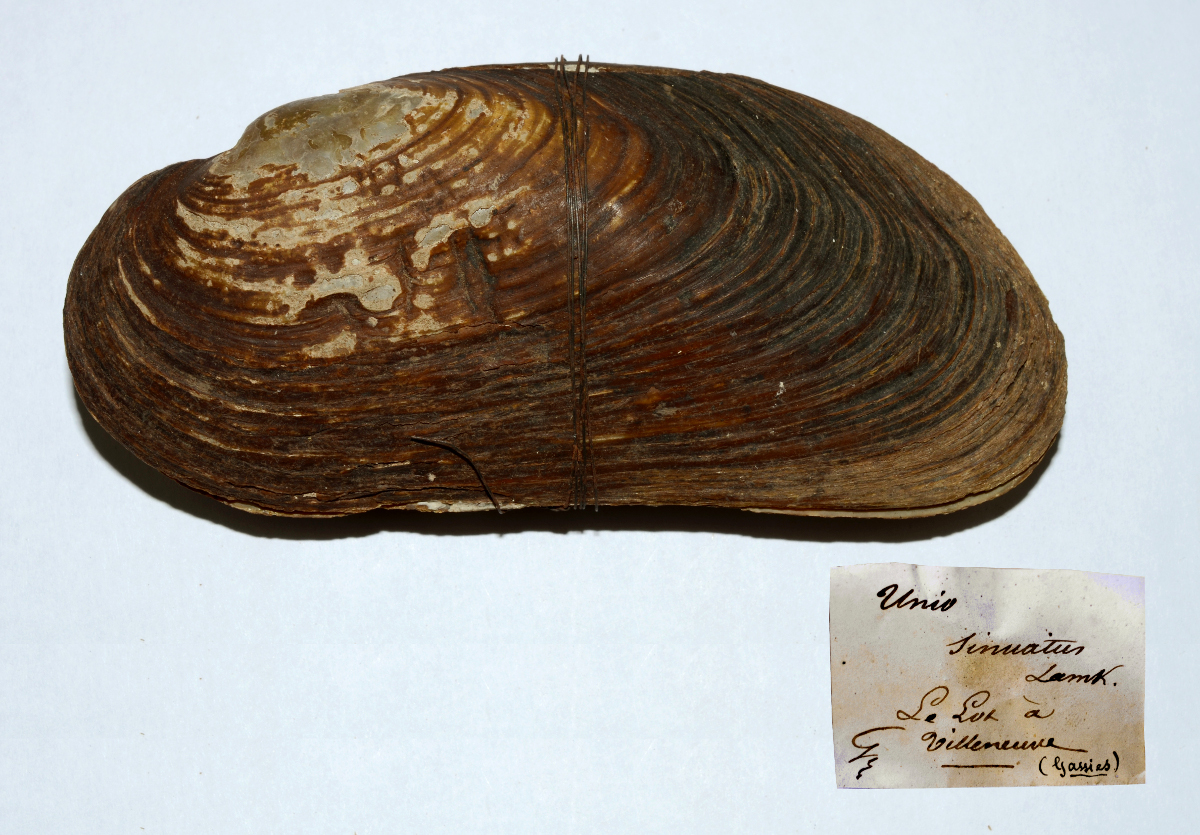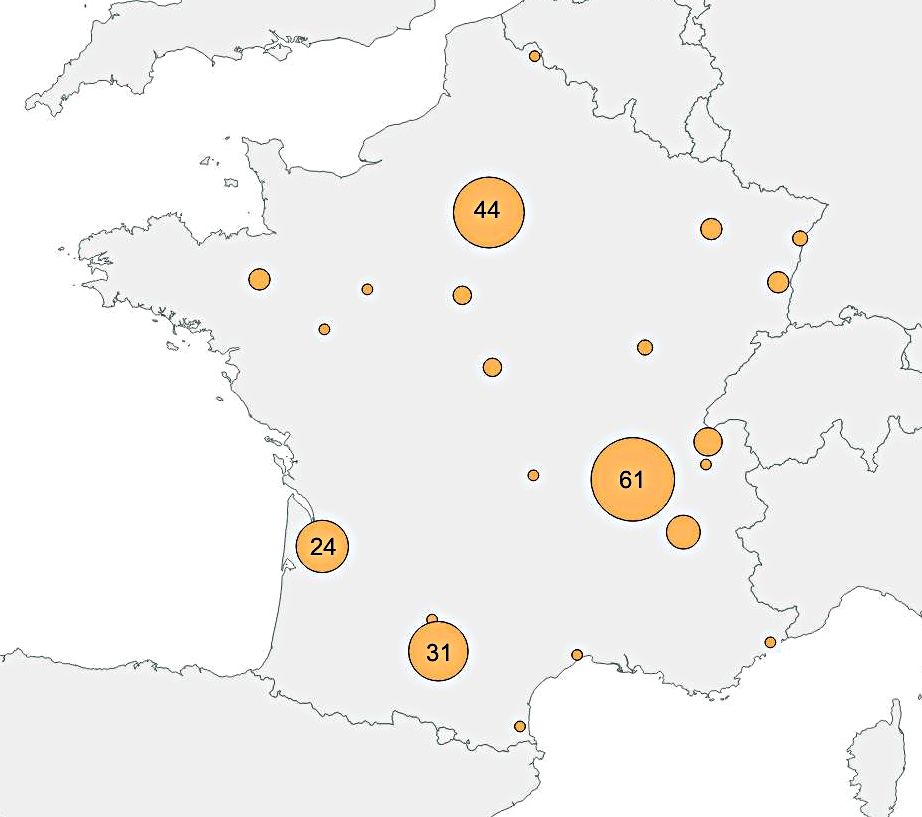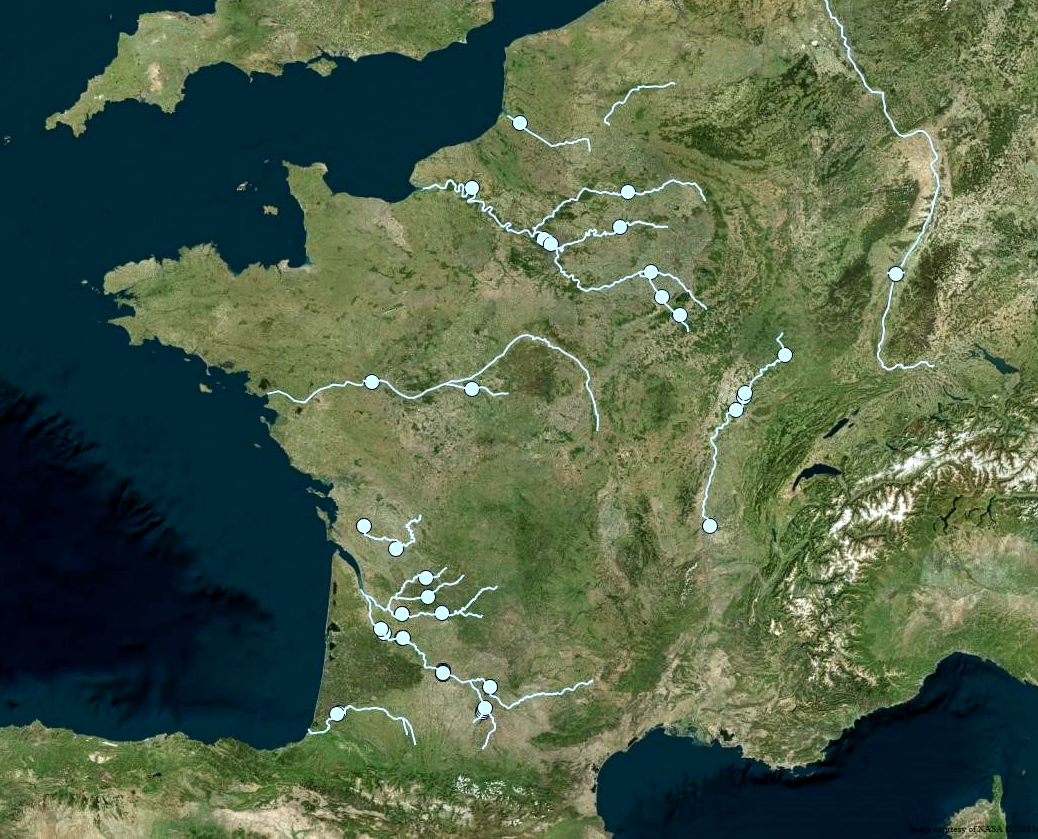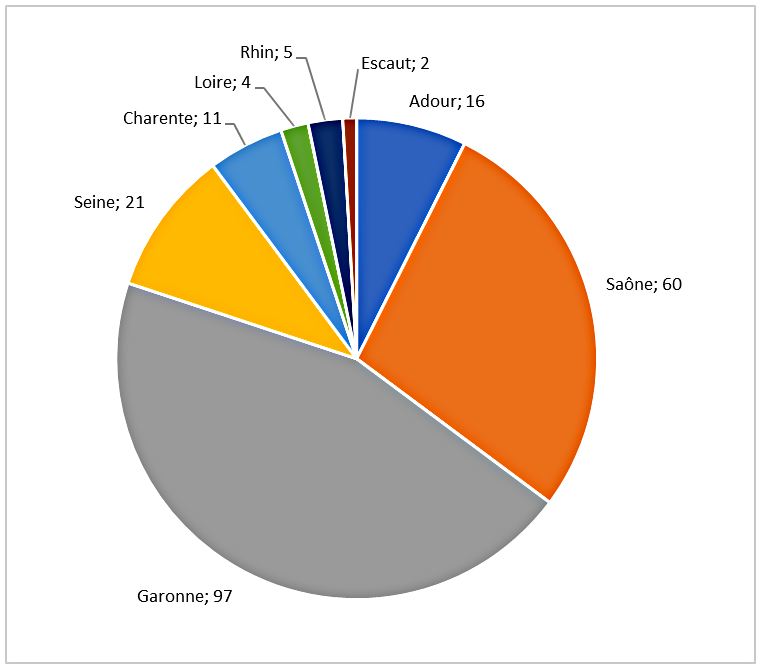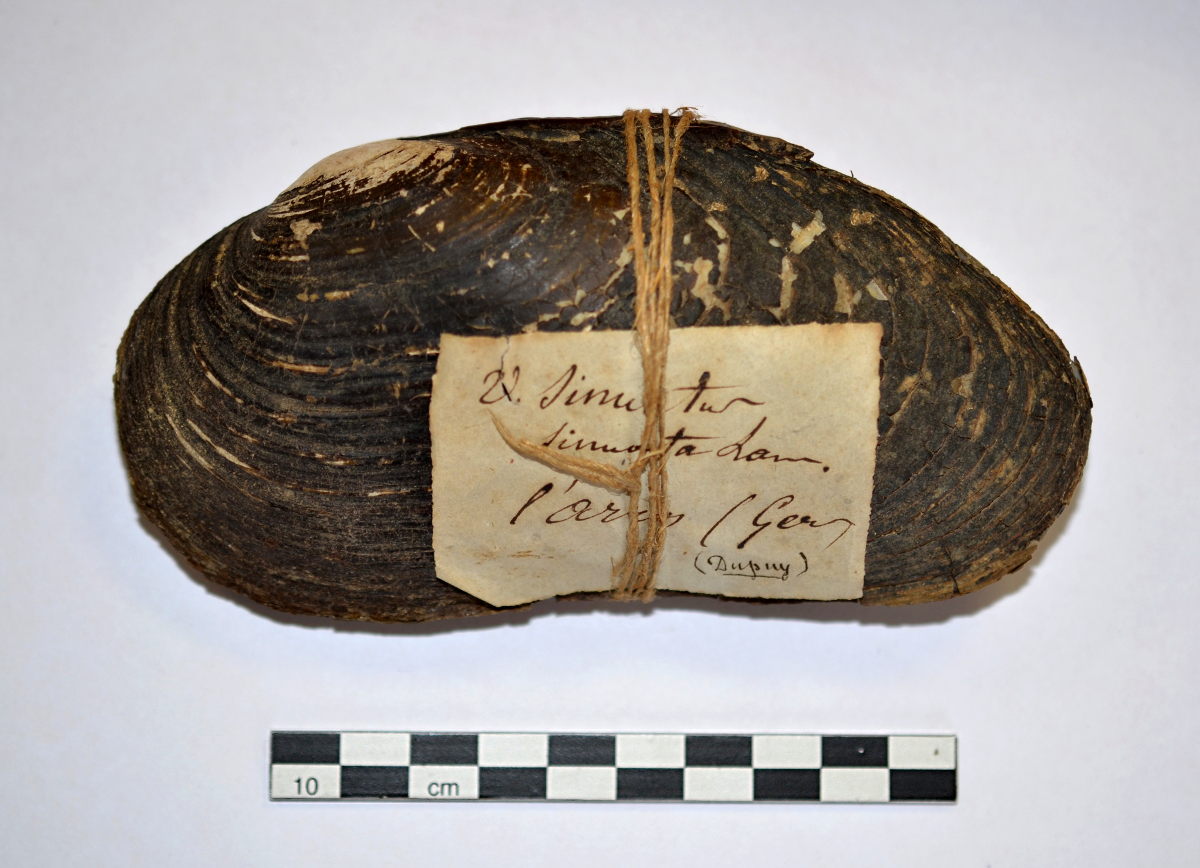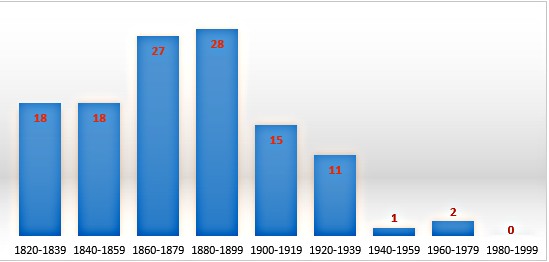What can we learn from regional museum collections? A reconstruction of historical distribution of the endangered Giant Freshwater Pearl Mussel Pseudunio auricularius (Spengler, 1793) in France
Que pouvons-nous apprendre des collections des musées régionaux ? Une reconstruction de la répartition historique de la Grande mulette Pseudunio auricularius (Spengler, 1793) en France
- Vincent Prié & Cédric Audibert
|
The Giant Freshwater Pearl Mussel Pseudunio auricularius is highly endangered. It has become so rare during the XXth century that it is difficult today to assess its original distribution. In this study, we investigated the collections of 61 regional museums and universities in France. 50 had specimens of Pseudunio auricularius, out of which 358 specimens could be localized to at least a portion of a river or a nearby town. Five localities were previously unknown and the amount of data collected per river or drainage was very different from what was known from the literature. Following this study, extensive surveys were performed using a team of scuba divers. This resulted in the discovery of shells and an overlooked population in a drainage that had been surveyed extensively a few years earlier. Mots clés : Regional Museums - universities - collections - Mollusca - Unionidae - Pseudunio auricularius - Giant Freshwater Pearl Mussel
La grande mulette Pseudunio auricularius est grandement en péril. Elle est devenue si rare au cours du XXe siècle qu’il est difficile aujourd’hui d’évaluer sa distribution originale. Dans cette étude, nous avons étudié les collections de 61 musées régionaux et universités en France. Cinquante avaient des spécimens de Pseudunio auricularius, dont 358 ont pu être localisés au moins à une portion de rivière ou aux environs d’une ville. Cinq localités étaient auparavant inconnues et la quantité de données collectées par rivière ou par drainage était très différente de celle connue par la littérature. A la suite de cette étude, des enquêtes approfondies ont été réalisées avec une équipe de plongeurs. Cela a permis de découvrir des coquilles et une population manquée dans un drainage qui avait été étudié de manière approfondie quelques années auparavant. Keywords: Musées régionaux - universités - collections - Mollusca - Unionidae - Pseudunio auricularius - Grande mulette |
|
When thinking about museum collections, one generally thinks of national museum collections (e.g. Araujo & Ramos, 2001). Indeed, for France, the massive Lamarck, Férussac, Germain and Locard collections are stored in the National Museum of Natural History in Paris. Other relevant collections are stored in foreign national museums: Bourguignat and Délessert collections are in Geneva (Switzerland), Draparnaud collection is in Vienna (Austria). However, regional museum collections are widespread in France, handled by curators and assistant curators, and together constitute a significant amount of material. Many important collections are stored in regional museums or universities: amongst others, the collections of: Normand (Museum of Lille), Hermann (Museum of Strasbourg), Lecoq (Museum of Clermont), Drouët (Museum and University of Dijon), Michaud, Terver and Coutagne (Museum of Lyon), Deshayes (University of Lyon), Dumont & Mortillet (Museum of Annecy), Gassies (Museum of Bordeaux), Moquin-Tandon and Rambur (Museum of Toulouse), Paladilhe (University of Montpellier), Chatenier and Gras (Museum of Grenoble), Couturier, Hagenmüller and Pallary (Museum of Marseilles), Caziot and Verany (Museum of Nice). In this study, we revisited the actual knowledge about the historical distribution of the endangered Giant Freshwater Pearl Mussel Pseudunio auricularius (Spengler, 1793) (= Margaritifera auricularia) (Fig. 1) in the light of museum collections data. Pseudunio auricularius was known from the literature to be widespread in Western Europe until the end of the 19th century. Since then, it has declined to a point that it was believed to be extinct when the European Habitat Directive species lists were established. Recently, a few populations have been re-discovered in France and Spain and the species is now listed in Annex II of the Habitat Directive, protected in France and Spain and considered Critically endangered (CR A2ac, Prié, 2010) by the IUCN. Subsequently, conservation programs have been set up aiming at artificial reproduction in order to re-introduce the species in the wild and trying to find remaining populations (Prié et al., 2018). For both purposes, we need a precise picture of the original distribution of P. auricularius, for a better understanding of its ecological requirement, to propose re-introduction sites and to know where to search for potentially remaining populations. Literature provides data on the original distribution of the species but is often too vague and remains deficient. In 2015, an extensive survey of regional museum collection has been set up to supplement the literature review of the species. This note presents the results of this survey 1. Fig 1. Pseudunio auricularius (Spengler, 1793), in the Lot river, Villeneuve, Lot-et-Garonne, Gassies leg. (Drouët's collection) - Muséum-Jardin des Sciences de Dijon |
|
We investigated and listed all the regional collections held in universities or museums in France (cf. Bertrand, 2001). Museums and some universities were contacted and information such as existing databases and pictures of shells and vouchers was collected. The most relevant collections were visited. When a database was available, special attention has been taken to the numerous synonyms of the species. A final database of the specimens of P. auricularius including specimen locality, date and collector (when available) could be established. Some specimens were collected in recent times (i.e. after 2000): 68 in Paris (leg. V. Prié 2007), 18 in Bordeaux (leg. Office national de l'eau et des milieux aquatiques) and one in Bourges (leg. Office national de l'eau et des milieux aquatiques). These specimens were not taken into account in this paper.
A total of 61 regional collections hosted by museums or universities were found. Of the 61 regional museums contacted in France, 11 could not be contacted for some reason or did not answer our request. Of the 50 remaining, 4 did not have any malacological collection. Out of these, 28 had at least one specimen of P. auricularius in their collections. The biggest collections of P. auricularius are present in Lyon, Paris, Toulouse, and Bordeaux (Fig. 2). A total of 392 specimens were identified in regional museum collections. Among them, 216 could be localised at least at the river scale (Fig. 3) and a collection date could be estimated for 159 of them.
Fig 2. Localization of Museums holding at least one specimen of P. auricularius. Dots are size in proportion to the number of specimens. Main collections in France are held in Lyon, Paris, Toulouse and Bordeaux
Fig 3. Collection places of specimens identified from Museum collections (dots, precise location; lines, rivers only) In their survey of national museums, Araujo and Ramos (2002) enquired 36 state museums. Six of them had shells collected in France (Academy of Natural Sciences of Philadelphia, Institut royal des Sciences naturelles de Belgique, Muséum d'histoire naturelle de Genève, Ohio State University Museum, United States National Museum, Instituut voor Systematiek en Populatiebiologie) representing 60 specimens collected in 13 French rivers (Adour, Aisne, Arros, Charente, Dordogne, Dronne, Garonne, Lot, Saône, Seine, Somme, Vesle, Yonne). Here, we show that regional collections not only add much more specimens (206), but also more localities (22 rivers: Adour, Aisne, Arrats, Arros, Aube, Charente, Chers, Dordogne, Dronne, Escaut, Garonne, Isle, Loire, Lot, Rhin, Saône, Save, Seine, Tarn, Vesle, Vézère, Yonne). Il Most of the specimens were collected in the Garonne drainage (Fig. 4). Amongst these, about a third were collected in one of the Garonne’s main tributary, the Dordogne drainage. Although living populations remain in the Garonne drainage, in the Dronne and the Save Rivers (Prié et al., 2018), such a proportion was unexpected. More surprisingly, another third came from the Garonne mainstream, between the towns of Agen and La Réole. La Réole is the place where the seas’ influence in the Garonne estuary ends (salinity occurs at least occasionally downstream La Réole). No populations nor shells are known nowadays from the Garonne mainstream.
Fig 4. Origin and number of specimens identified in French Museum collections Over a quarter of the shells identified in museum collections came from the Saône drainage. Noticeably, 39 of the 60 shells came from the Coutagne collection and were collected in a single place: a gravel mound left on the banks of the Saône after the river had been dredged. Twenty-one shells came from the Seine drainage, were the species is supposed to have recently disappeared (Prié et al., 2008; Prié et al., 2018). Shells can still be found nowadays in tributaries to the Seine such as the Oise and Aisne Rivers. Fifteen shells came from the Adour drainage, where a few hundreds of specimens are still living. But half of them came from the Arros tributary, a river that had been overlooked by previous field surveys (Fig. 5).
Fig 5. Pseudunio auricularius (Spengler, 1793), in the Arros river, Gers, Dupuy abbot leg. Only eleven shells came from the Charente River. This low number of shells was unexpected as the Charente River hosts the biggest population of Giant Freshwater Pearl Mussels in the world (Prié et al., 2018), and this population was known from a long time as industries were set up to make mother-of- pearl buttons out of the shells (Bonnemère, 1901 ; Faideau, 1938). A collection date could be estimated for 159 specimens (Table 1). If we exclude from the dataset the particular case of the Coutagne’s collection in 1879, with 39 shells collected at one time on the bank of the Saône River after dredging, we observe that the rate of shell collection is more or less regular, between 8 to 15 per decade (Fig. 6). By the early XXth century, this collection rate begins to decline, ending with no shells collected at all at the end of the XXth century. This plunge is correlated with what is assumed about the species decline. Ancient literature considers the species as widespread in Western Europe up to the 1900s, while it was even not considered in the lists of threatened species in 1979 when the Habitat Directive was implemented, because scientists thought it was already extinct. However, this approach is biased by (i) the rarity of the collections in the first third of the XIXth century, and (ii) the global decline of collections after 1920. Noticeably, most shells were collected during the XIXth and early XXth centuries in “big collections”, but most malacologists collections do not contain any P. auricularius shells, or only a few (e.g. Drouët’s collection, with many unionids but very few P. auricularius).
Table 1. Number of specimens deposited in museum collections per 20 years
Fig 6. Number of specimens per collection dates intervals. This figure does not include the particular case of Coutagne’s collection in 1879.
|
|
The Giant Freshwater Pearl Mussel remains an extremely rare and endangered species. The rarity of shells in collections reflects not only a rarity in nature, but also the fact that it is was difficult to collect: the Giant Freshwater Pearl Mussel lives in the bottom of large rivers, downstream, with generally turbid waters (see Prié et al., 2018) and is thus much harder to collect that its related species the Freshwater Pearl Mussel Margaritifera margaritifera, which in France generally lives in shallow, clear and pristine rivers of the upstream ecosystems. However, although scarce, the data collected in this study allowed discovering previously unnoticed data. In particular, we remarked on the shells from the Arros River, found in very low number but in many collections. The Arros River had been completely overlooked by the last decade program of field surveys aimed at rediscovering the species in France. This observation lead to a field survey, in 2016, in this river and a living population could be rediscovered there, numbering about 200 specimens (Prié et al., 2018). Museum collections are not only valuable for reconstructing the past, they can also enlighten the present situation.
We are grateful to all the museum curators who answered our solicitations, and in particular to Benoît Mellier (Muséum d'Angers), Bruno Cottin (Musée-Château d’Annecy), Gilles Pavy (Muséum d’Auxerre), Pascal Leblanc (Muséum de Besançon), Laurent Charles (Muséum de Bordeaux), Ludovic Besson (Muséum de Bourges), Eliane Paysant & Marc Damerval (Muséum de Cherbourg), Marie-Françoise Faure (Muséum Henri-Lecoq, Clermont-Ferrand), Marie Boigues (Muséum d’Histoire naturelle et d’Ethnographie de Colmar), Stéphane Puissant & Monique Prost (Muséum-Jardin des Sciences de Dijon), Jérôme Thomas (Université de Bourgogne, Dijon), Philippe Candegabe (Muséum de Grenoble), Nicolas Morel (Muséum du Mans), Aude Bergeret (Musée Victor Brun de Montauban), Magali Auriat (Musée-Aquarium de Nancy), Marie Dartige (Muséum de Nantes), Olivier Gerret (Muséum de Nice), Michel Binon (Muséum d’Orléans), Virginie Héros & Philippe Maestrati (Muséum national d’Histoire naturelle, Paris), Didier Mary & Amy Benadiba (Muséum de Perpignan), Pierre-Yves Pasco (SEPNB - Bretagne vivante, information from Muséum de Rennes), Laura Lévêque (Musées de Saint-Omer), Antoine Wagner (Muséum de Strasbourg), Henri Cap (Muséum de Toulouse), Grégoire Ghislain (Pôle muséal de Troyes). |
|
Araujo, R. & Ramos, M. A., 2000. A critic revision of the historical distribution of Margaritifera auricularia (Spengler, 1793) (Mollusca: Margaritiferidae) based on museum specimens. Journal of Conchology, 37(1): 49-59. Araujo R. & Ramos M. A., 2001. Action plans for Margaritifera auricularia and Margaritifera margaritifera in Europe. Council of Europe Publishing, Strasbourg, 64 pp. Bertrand R., 2001. Les collections des Muséums d’Histoire naturelle en France. Ministère de la Recherche, 55 pp. + 12 pp. maps. Bonnemère L., 1901. Les mollusques des eaux douces de France et leurs perles. Paris, Institut international de bibliographie scientifique, 154 pp. Faideau M.F., 1938. Les perles d’eau douce en Saintonge. Annales de la Société des Sciences Naturelles de la Charente-Maritime, 3(5) : 37-52. Prié V., 2010. Margaritifera auricularia. The IUCN Red List of Threatened Species 2010: e.T12798A3381899. http://dx.doi.org/10.2305/IUCN.UK.2010-4.RLTS.T12798A3381899.en. Downloaded on 20 June 2019. Prié V., Cochet G., Philippe L. 2008. La Grande Mulette Margaritifera auricularia dans l’Oise : Chronique d’une disparition annoncée. Le Courrier de la Nature, 239: 20-24. Prié V., Soler J., Araujo R., Cucherat X., Philippe L., Legrand N., Patry N., Adam B., Jugé P., Richard N. & Wantzen K. M., 2018. Challenging exploration of troubled waters: a decade of surveys of the giant freshwater pearl mussel Margaritifera auricularia in Europe. Hydrobiologia, 810: 157-175. https://doi.org/10.1007/s10750-017-3456-0 |
|
|
Vincent Prié Cédric Audibert |
| Prié V. & Audibert C., 2019. What can we learn from regional museum collections? A reconstruction of historical distribution of the endangered Giant Freshwater Pearl Mussel Pseudunio auricularius (Spengler, 1793) in France. Colligo, 2(1). |

